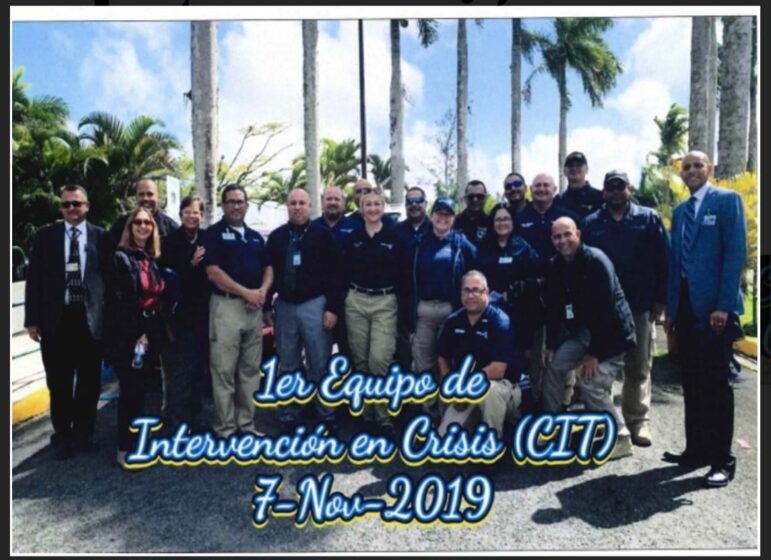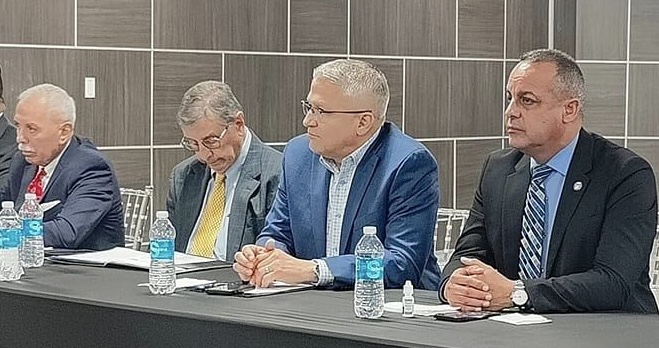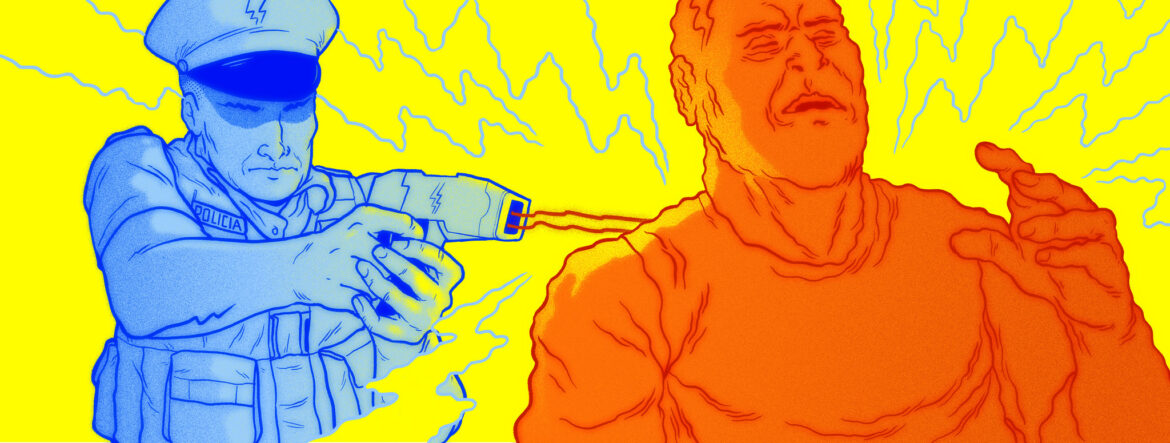When Roxana Sánchez Pérez saw her husband, Iván Lourido Alverio, break the mirror doors of a small closet in their home in Morovis, Puerto Rico, she knew it was time to seek help. It wasn’t the first time that Lourido Alverio, who has a history of depression and anxiety, suffered an apparent mental health crisis. In the past, these episodes had become so severe that they required at least three hospitalizations in psychiatric units.
That time, Sánchez Pérez did not seek help from a mental health professional, but instead followed the usual protocol in Puerto Rico: she went to the nearest Police station and told the agents there what was happening at home. She told them she feared for her safety and urgently needed “a 408,” as most people refer to the court order that gives authorization to involuntarily commit someone experiencing a mental health crisis to a hospital.
That night of Feb. 11, 2020, near dawn, Sánchez Pérez returned to the home she shares with Lourido Alverio and the couple’s grown daughters, accompanied by five uniformed police officers. The agents arrived at the Morovis neighborhood in patrol cars to enforce the order issued by an Arecibo Court judge. Lourido Alverio, 42, was to be transferred to a hospital to receive psychiatric care.
After an hour and a half of trying to get the man, who was locked in the house, to calm down, the police used a Taser on him to carry out the judge’s order.
“I heard him shouting: ‘You’re going to kill me; you’re going to kill me.’ He screamed: ‘It hurts,’” Sánchez Pérez, Lourido Alverio’s wife, recalled in a recent interview about the incident. Her husband ended up in a hospital in Manatí where a doctor had to remove the Taser darts that were stuck in him. They were embedded in his right knee and the left side of his waist. From that hospital, he was transferred again by ambulance to another institution — this time, in San Juan — where he finally began receiving the mental health care he needed.
The experience of Sánchez Pérez, who waited outside her house as she heard the agents intervening with her husband, and that of Lourido Alverio, who has since resumed his psychiatric treatment, is not isolated in Puerto Rico. The Center for Investigative Journalism (CPI, in Spanish) quantified, reviewed, and analyzed hundreds of Puerto Rico Police use of force reports from incidents between 2018 and 2021 in the San Juan and Arecibo regions, and found that between 23% and 30% of these interventions happened against people who were suffering an apparent mental health crisis. In more than half of these cases, the agents used a Taser, which can be lethal and, otherwise, represents a health risk for the person receiving the electric shock.
In 2011, the United States Department of Justice concluded that the Puerto Rico Police systematically and recurrently committed civil rights violations, and among the main allegations of unconstitutional practices was the use of excessive force in their interventions. In response to these findings, which confirmed what civil society organizations had denounced for years in Puerto Rico, the federal and Puerto Rican governments agreed in 2013 that the Police should carry out a comprehensive reform. The reform seeks to transform the police training offered and requires agents to improve how they collect and report information about interventions.
It has been 10 years since the Police Reform began under the supervision of the U.S. District Court in Puerto Rico, and changes are moving slowly, despite the $20 million in public funds that the Government of Puerto Rico allocates to the reform annually. Last September, U.S. District Court Judge Francisco Besosa, responsible for the Reform case, ordered the Puerto Rico Police Bureau to adjust its strategy because, after a decade, “monumental changes remain to occur.”
“The Court finds the pace at which the reform is progressing less than acceptable,” Besosa stated in an order dated Aug. 17, 2023, in which he criticized the Bureau because, according to the most recent findings by the federal monitor that supervises the Reform, the Police still fail to comply in 56 of the most important aspects among the 179 they agreed to reform.
One aspect that is still non-compliant within the use of force section is the modification of intervention strategies with mental health patients. The Police launched a pilot project in the Arecibo Region in 2019 to try a model developed in 1988 in the U.S. known as Crisis Intervention Team or CIT. Participating police officers receive a 40-hour CIT training that seeks to sensitize them to the needs of a person experiencing a mental health crisis and provide them with de-escalation tools for these interventions. In some jurisdictions, these programs also involve mental health and community professionals, but the Puerto Rico project is staffed only by police officers.
“As an agent, I’m not a mental health professional, but [with this training] I have some criteria to see how I’m going to work with that person,” Police Sergeant Thayra Negrón Meléndez, coordinator of the CIT pilot program in Arecibo, said in an interview. “Before the [CIT pilot] program, excessive force was used. There was even the use of firearms. That has already been limited.”

Courtesy photo
Although the CIT pilot program officially ended in 2020, Negrón Meléndez said she and her team of 11 officers from the Arecibo Region of the Puerto Rico Police continue to work as a specialized group. Since the program’s implementation, most interventions with mental health patients in that region end without the use of force, Negrón Meléndez said.
CPI asked the Police Bureau for an interview with Commissioner Antonio López Figueroa and with senior representatives in charge of the pilot program and the Reform, but the officials did not respond to the request. Among other things, CPI wanted to ask about the performance of the pilot program, the initiative’s future, and get verifiable data and statistics on all police interventions since its implementation, not just those in which there was use of force. Alternatively, questions were sent but had not been answered as of the time of publication. Damarisse Martínez, press officer for the Bureau, said she would send the responses as soon as the different divisions of the Police provided them.
In his eighth report published in June of this year, Police Reform monitor John Romero stated that the CIT pilot program officially ended in November 2020, and that, three years later, the Puerto Rico Police still had not offered a final evaluation on its implementation to the court.

Photo taken from the Department of Public Safety’s Facebook page.
“The Bureau has lagged in its efforts to complete an evaluation of the pilot program and expand it to other areas of the island,” Romero said in his most recent report. Meanwhile, Sergeant Negrón Meléndez told CPI that during 2023 they gave CIT training to about 50 other agents, who they want to use to expand the program to other regions.
For this investigation, CPI analyzed use of force reports from the Arecibo Region between 2018 – before the CIT pilot program – through 2021 – when it had officially ended, but, according to Negrón Meléndez, remained in operation. Of the 185 incidents in which the Arecibo Police reported that they used some type of force against a person during those four years, 56 of those cases or 30% were against people who were experiencing a mental health crisis.
In six out of 10 of the incidents in which force was used against people experiencing a mental health crisis (61%), officers used a Taser or, as they call it in their official reports, an electronic device. There were 34 people in the Arecibo Region who received at least one electric shock from the Police while suffering a mental health crisis, and one of them was Lourido Alverio that early morning in February 2020.
The use of force report written by agent Joel García Echevarría, who fired the Taser at Lourido Alverio, says that, after an hour and a half of trying to get the man to come out to enforce the involuntary commitment order, the Police managed to get into the house. García Echevarría, who according to the reviewed reports was part of the CIT team, said Lourido Alverio then came out of a bedroom “aggressive, shouting insults, using foul language, and uncooperative.”
“He got too close to me [and] I made the determination to use the control of the electronic device, to safeguard his life and my safety,” said García Echevarría, who, in the period from 2018 to 2021, was involved in at least two other incidents in which a person who was experiencing a mental health crisis was shocked using a Taser.
García Echevarría’s version contradicts the account of the incident that Lourido Alverio’s wife gave to CPI, which is based on what her husband told her as she was outside the door when he was tasered. When the police entered by surprise, Lourido Alverio walked to a closet to get a towel, Sánchez Pérez said. It was then that García Echevarría fired the Taser darts at him. The shock caused Lourido Alverio to fall to the floor in front of the closet, which is about 12 feet away from where she said the officer was standing.
“I heard the blow when he fell to the floor, and I was near the window when he was shouting: “You’re killing me, you’re killing me,” and then they took him out handcuffed, with those two darts stuck in him, one next to his belly button and the other in his leg,” said Sánchez Pérez.
The Taser, a misleading weapon
Today, Tasers are everywhere. Virtually every police department in the United States uses them, Michael White, a criminal justice professor and researcher at Arizona State University, told CPI in a recent interview.

Photo by Charlie Leight | Arizona State University
And while many believe that it is a harmless weapon, the electric current discharged by the Taser can have serious health consequences and even be fatal. Academic studies and the Puerto Rico Police manuals themselves warn that it is a potentially lethal weapon.
“Conducting more than three five-second shocks or exposure to the effects for more than 15 seconds against the same person or animal has a high probability of resulting in a serious health risk or death during an incident,” according to the Puerto Rico Police General Order on the use of the Taser, revised in November 2022.
In the Arecibo Region, officers used more than one electric shock in 14 of the 34 incidents (41%) in which they used a Taser on a person experiencing a mental health crisis, according to CPI’s analysis of the incident reports from 2018 to 2021.
A review of use-of-force reports in the San Juan Region, where the Police did not have a special protocol for addressing mental health calls in practice, revealed a pattern like that of the Arecibo region. However, in the capital city, agents used Tasers more frequently.
Among the 365 use-of-force cases against people reported by police between 2018 and 2021 in the San Juan Region, 85 or 23% occurred against people who were going through an apparent mental health crisis. In 54% of the cases, officers used a Taser on a person experiencing a mental health crisis, and half of the time officers used the Taser more than once. In some cases, the Police fired a Taser as many as four or five times against the same person.
Police reports don’t always classify interventions, so to identify cases related to mental health crises, CPI had to read the reports for 596 interventions with use of force reported in San Juan and Arecibo between 2018 and 2021. CPI classified the interventions based on the information available in these reports, particularly the accounts of the police officers and the supervisors who evaluate the incident to determine whether the use of force is justified. Given this, there may be cases in which a person in crisis was involved but was excluded from the count because that circumstance was not included in the personal information boxes nor the narrative portions of the report. Across the about 3,900 pages of reports analyzed, supervisors determined that the use of force was justified in most cases.
Greater danger for mental health patients
In 2009, Criminal Justice Professor White and his colleague Justin Ready published a study of Taser use incidents reported in the U.S. media between 2002 and 2006. Their analysis of 521 articles on different incidents noted that while deaths caused by Tasers are rare events, the risk of death appeared to increase when Tasers were discharged more than once against people experiencing an emotional crisis.
They found that, among news media articles reporting on Taser deployment by police, fatalities were far more commonly reported in cases where a person was experiencing a mental health crisis and had a Taser used against them twice or more.
A Taser discharge causes deep, widespread pain, explained White, who was shot with one of the devices as part of his studies.
“Most times when you think of something painful, it’s very localized. If you cut yourself or if you have a burn, you can have significant pain but basically, it’s just in that one area where you’ve been injured,” White explained. The pain that a Taser provokes is “not localized at all. I felt it in my entire body. I wouldn’t describe it as a superficial pain, it was a deep-in-your-bones kind of pain… It is extraordinarily painful.”
White said that, in addition to this immense pain, the Taser practically paralyzes the person while the electric current is active. Puerto Rico Police officers have used this to control and immobilize those who don’t follow their instructions or resist arrest, CPI’s findings show.
But White and Ready stated in their study that people experiencing a mental health crisis are less likely to comply with police orders given their state of emotional distress and that, when the police decide to use their Taser against them, their risk of death may be higher than among other groups of people.
Police tactics for a health problem
Ángel, a 50-year-old mental health patient from the Arecibo Region, was given two electric shocks by the Police when he resisted being transported to the hospital against his will. It was not the first time that he needed emergency psychiatric help, but even knowing his history, the police officers who went to Ángel’s house to enforce the court order decided not to activate the crisis intervention (CIT) group.
“In my presence, Officer [Brenda] Pérez asked [Ángel’s mother] if he was an aggressive person with everyone and she answered that he only got aggressive with her, so Officer Pérez and I chose not to inform the Arecibo area crisis intervention group,” Sergeant Juan D. Ruiz Morales, who was the shift supervisor at the time of making this decision, wrote in his use of force report.
On a Saturday in May 2021, the police and paramedics arrived at the house to carry out the court order against Ángel, whom CPI identifies only by his first name to protect his privacy. When they got there, he was inside the bathroom and said he would come out after taking a shower. The officers waited just 15 minutes before one of the paramedics decided to open the bathroom door, which was unlocked, and tell Ángel that he had to go with them.
Ángel initially refused, but after a neighbor intervened, he agreed to leave. A police officer and a paramedic grabbed him by the arms to take him to the ambulance. On the way to the ambulance, Ángel saw his mother and then he broke free of their grip and threw his fists in the air to prevent them from taking him away, according to Sergeant Ruiz Morales’ report. It was then that Ruiz Morales delivered two five-second shocks with the Taser, first on the left side of Ángel’s torso and then on his chest.
After tasing him, the agents threw Ángel on the ground, handcuffed him, and took him to the ambulance. The supervisors who issued or signed the reports in the days after the incident — Lieutenant Alexis González Morales, Captain Rafael Asencio Terrón, and area commander Israel Rojas Velázquez — determined that the use of force in this intervention “was justified and responsibly done,” that the police officers followed “the rules and policies” of the Bureau, and that the incident did not merit an internal investigation.
Negrón Meléndez, the sergeant in charge of the Arecibo crisis intervention team, said in an interview that one of the most important skills when treating a person going through a mental health crisis is not to rush. “We don’t think about time,” said Negrón Meléndez. Ángel was not that lucky. Less than an hour passed from the arrival of the police –who ruled out activating the CIT– and the use of the Taser against Ángel, according to the data provided in the use of force report.
Just two months after this incident, in July 2021, the Police went to the home of Francisco, 46, a resident of the Arecibo Region, because he was threatening to commit suicide. Francisco also had a history of mental health crises, and his sister, who had requested a 408 order for his involuntary hospitalization, had noted that he was being aggressive.
On the way to Francisco’s house, Sergeant Samuel Galloza alerted the crisis intervention team, and CIT-trained Officer Carlos de Jesús went to the house. With Francisco barricaded in his house, the officers decided to force their entry into the residence, and the man then locked himself in a room, according to the police report. Officer De Jesús remained in communication with Francisco, talking to him through the closed door for four hours until he convinced him to leave the room to get help.
Although Officer De Jesús’s appeasement strategies worked, once Francisco left the house toward the garage, the intervention was once again treated as a police matter. Lieutenant Alexis Soberal Serrano ordered his subordinates to arrest Francisco and the man – who had come out willing to be helped – “tensed up” when they tried to arrest him.
“With my hands, I grab him by the right arm and twist it and take it toward the area of his back,” Soberal Serrano said in his use of force report. Although he was not tasered like others in this situation, Francisco – who was going through a mental health crisis – left his house handcuffed, under police custody, and on his way to the police station. There, paramedics treated him and finally took him to a hospital in Utuado so he could begin receiving the mental health care he needed
Psychologist Mayra Olavarría Cruz, professor at the University of Puerto Rico’s School of Medicine, said police training can be useful so they learn to deal with the pressures of crisis interventions, but an even better alternative would be the possibility of them working alongside mental health professionals, such as psychologists or psychiatrists, who would join emergency response teams.
“It is not that 100% of the cases will be resolved with that, but [mental health professionals] could de-escalate the situation and could negotiate with the patient,” said the clinical psychologist, who for 16 years worked as an instructor of a crisis prevention program with mental health patients. Olavarría Cruz, who works at the Psychiatry Clinic of the Medical Sciences Campus, added that, in the meantime, it would also help if the police officers who work in these interventions do so without wearing the uniform or other badges that the patients — sometimes, given previous experiences — may associate with violent situations or threats to their safety.
Sergeant Negrón Meléndez, leader of the CIT program in Arecibo, believes that police officers must be trained to learn how to handle mental health crises because they will always face them, but that these interventions require a multidisciplinary response.
“Crisis intervention shouldn’t begin with the presence of a police officer. It should be with the presence of a mental health professional. Should the service be combined? Of course, we can assist,” said Negrón Meléndez. “But, as a police officer, I can say that, from the beginning, mental health must be worked on, not through police intervention, but by a mental health professional.”
This investigation was made possible in part by support from non-profit organization Kilómetro 0 and the USC Annenberg Center for Health Journalism’s 2023 National Fellowship. This story is part of a collaboration between the Center for Investigative Journalism and the Medill Investigative Program at Northwestern University on police response to mental health crises.





